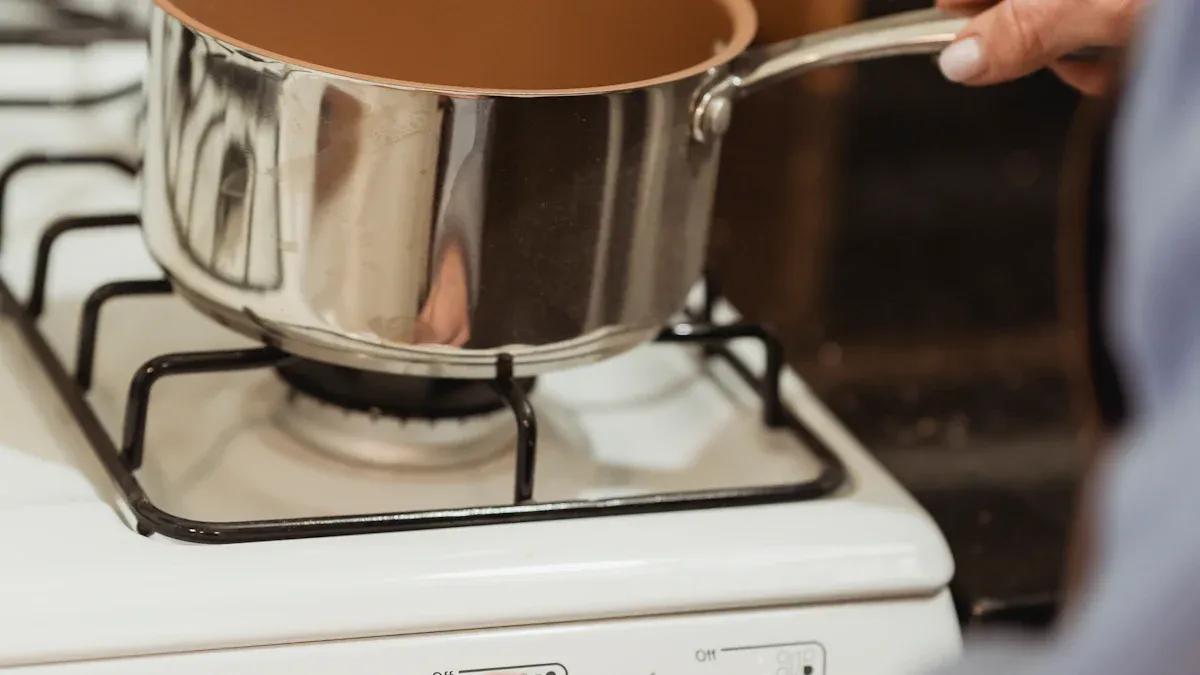
Oven heating elements can malfunction for various reasons, and knowing these causes can save time and frustration. Factors like wear and tear on the heating element for oven, electrical issues, or even improper use of oven heat elements can lead to problems. Understanding these issues helps in troubleshooting effectively. When you recognize the signs early, you can address them before they turn into bigger headaches, whether it’s related to the hot water heating element or the heating element for water.
Key Takeaways
- Recognize signs of a failing heating element, such as no glow, physical damage, and uneven cooking. Early detection can prevent bigger issues.
- Regularly clean your oven and inspect components to maintain performance. This simple step can extend the lifespan of your heating element.
- Use a multimeter to test the heating element’s functionality. A reading outside 10-100 ohms indicates a need for replacement.
- Consider the age and condition of your oven when deciding to repair or replace the heating element. Sometimes, investing in a new model is more cost-effective.
- Implement preventive measures like avoiding foil on racks and monitoring temperature settings to reduce the risk of malfunctions.
Signs of a Failing Heating Element

Recognizing the signs of a failing heating element can save you from a lot of cooking headaches. Here are some key indicators that your oven’s heating element might be on the fritz:
- No Glow: When functioning properly, the heating element should glow bright orange. If it doesn’t light up at all, it may be burned out.
- Physical Damage: Check for any visible signs of wear. Look for burns, scorch marks, or cracks on the element. These can indicate serious issues.
- Uneven Cooking: If your food comes out undercooked or unevenly cooked, it’s a strong sign that the heating element isn’t distributing heat properly.
- Excessive Dirt: A buildup of dirt and grime can affect performance. If you notice a lot of debris around the heating element, it might be time to clean or inspect it.
- Higher Electricity Bills: A sudden spike in your electricity bill could mean the heating element is malfunctioning and drawing more power than usual.
Users often report that a malfunctioning heating element leads to inadequate heating. Common signs include failure to heat, visible damage, and uneven temperature distribution. If the heating element doesn’t glow red or orange when in use, it’s a clear indication of a problem.
Additionally, some ovens display error codes related to heating element issues. These codes can alert you to problems with temperature sensors or control systems. For instance, common error codes include:
- F3 – Oven temperature issue
- F3 E0 – Open sensor circuit
- F3 E1 – High oven temperature
- F3 E2 – Shorted sensor
- F3 E3 – Open sensor
If you notice any of these signs, it’s crucial to address them promptly. Ignoring these symptoms can lead to more significant issues down the line.
Common Causes of Malfunctions

When it comes to oven heating elements, several common issues can lead to malfunctions. Understanding these causes can help users troubleshoot effectively. Here are some of the leading culprits:
-
Broken Bake or Broil Element: A damaged element can prevent the oven from reaching the desired temperature. If the element looks burnt or cracked, it’s likely time for a replacement.
-
Faulty Thermostat: This component regulates the oven’s temperature. If it malfunctions, it can cause temperature fluctuations, leading to uneven cooking. A malfunctioning thermostat might even cause the oven to fail to heat or overheat, which can ruin meals.
-
Control Board Issues: The control board sends signals to the heating elements. If it has problems, it may not communicate effectively, resulting in a cold oven.
-
Power Supply Problems: An inadequate power supply can lead to inconsistent heating. If the oven doesn’t receive enough power, it won’t heat properly, which can be frustrating during meal prep.
-
Electrical Overload: Overloading the heating system can lead to failures. When components exceed their rated capacity, they can overheat, posing fire hazards. This highlights the importance of using compatible components within the heating system.
By being aware of these common causes, users can take proactive steps to maintain their heating element for oven and ensure it operates smoothly. Regular checks and timely repairs can save time and money in the long run.
Troubleshooting Steps for Heating Element For Oven
When your oven heating element starts acting up, troubleshooting can feel daunting. However, following a systematic approach can help you identify the problem and potentially fix it. Here are some essential steps to guide you through the process:
-
Power Down: Always turn off your oven before starting any repairs. This step is crucial for your safety. Disconnect the oven from its power source to avoid any electrical hazards. Confirm that the oven has no power by checking that the display and lights are off.
-
Inspect for Damage: Look closely at the heating element for any visible signs of wear or damage. Cracks, burns, or scorch marks can indicate that the element needs replacement. If you notice any physical damage, it’s best to replace the heating element for oven.
-
Use a Multimeter: A multimeter is a handy tool for diagnosing heating element issues. It allows for continuity and resistance testing, which is vital for determining functionality. A healthy heating element should show a resistance reading between 10-100 ohms. If your readings fall outside this range, it’s time for a replacement.
-
Check Circuit Breakers: Sometimes, the issue isn’t with the heating element itself but with the power supply. A tripped circuit breaker can cut power to the oven, making it seem nonfunctional. Inspect the circuit breaker for any visible damage and ensure it hasn’t tripped. If it frequently trips, this could indicate an overcurrent flow due to faulty components.
-
Remove the Element: If you suspect the heating element is faulty, you may need to detach it for further inspection. Use a screwdriver to remove the faulty igniter or heating element, typically found inside the oven. If the heating element is not easily accessible, consider hiring a professional for replacement.
-
Safety Precautions: Always prioritize safety when troubleshooting. Wear dry, heat-resistant gloves and safety glasses. Remove any flammable materials from the area, and never touch electrical parts with wet hands. Place a reminder note on the breaker or oven to prevent accidental power restoration while you work.
-
Common Mistakes to Avoid: Be aware of common pitfalls during troubleshooting. Here’s a quick table of mistakes to watch out for:
Mistake Description Overlooking Tripped Circuit Breakers A common issue where the circuit breaker is tripped, cutting power to the oven. Misdiagnosing Thermostat Problems Incorrectly identifying thermostat issues can lead to unnecessary part replacements. Failing to Check for Physical Damage Not inspecting the heating element for visible damage can result in missed failures.
By following these troubleshooting steps, you can effectively diagnose issues with your heating element for oven. If you find that the problem persists after these checks, it may be time to consult a professional technician for further assistance.
Repair vs. Replacement of Heating Element For Oven
When your oven heating element malfunctions, you might wonder whether to repair it or replace it entirely. This decision can depend on several factors. Here’s a breakdown to help you make an informed choice:
- Age of the Oven: If your oven is older, it might be less cost-effective to repair. Newer models often come with energy-efficient features that can save you money in the long run.
- Severity of the Issue: Minor issues, like a small crack, can often be repaired. However, if the heating element shows significant damage, replacement might be necessary.
- Energy Efficiency: New heating elements are generally more energy-efficient. Upgrading can lead to lower utility bills, making it a smart investment.
- Additional Features: Modern ovens offer advanced features that enhance cooking convenience. If you’re considering an upgrade, think about what new functionalities you might want.
- Your Budget: Weigh the cost of repairs against the price of a new oven. Sometimes, spending a little more on a new model can save you money in the long run.
Here’s a quick look at the costs involved:
| Action | Cost Range |
|---|---|
| Repairing a heating element | $150 to $400 |
| Replacing a heating element | $150 to $450 |
Interestingly, the average cost difference between repairing and replacing a heating element is minimal, typically around $0 to $50. For example, repairing a heating element usually costs between $150 and $400, while replacing one ranges from $150 to $450.
Ultimately, the choice between repair and replacement comes down to the specific situation. If the heating element for oven shows signs of severe wear, replacement may be the best option. However, if it’s a minor issue, a repair could extend the life of your oven without breaking the bank.
Preventive Measures for Heating Element For Oven
Taking care of your oven’s heating element can significantly extend its lifespan and improve cooking performance. Here are some effective preventive measures to keep in mind:
-
Regular Cleaning: Clean the oven’s interior at least once a month. Use non-abrasive cleaners to avoid scratching the heating element. Regular cleaning prevents grease buildup, which can lead to overheating and damage.
-
Inspect Components: Routinely check components like door hinges and seals. This helps identify any wear and tear that could lead to heat loss or longer cooking times.
-
Avoid Foil on Racks: Never line the bottom of your oven with foil. This practice can cause overheating and damage the heating element. Instead, use proper cookware that allows for even heat distribution.
-
Sparing Use of Self-Cleaning Features: While self-cleaning ovens are convenient, using this feature too often can put unnecessary strain on the heating element. Limit its use to maintain optimal performance.
-
Monitor Temperature Settings: Follow the manufacturer’s guidelines for temperature settings. This helps prevent thermal stress on the heating element, ensuring it operates efficiently.
-
Guard Against Power Surges: Use surge protectors to shield your oven from electrical spikes. Power surges can damage internal components, including the heating element.
-
Schedule Annual Inspections: Consider having a professional inspect your oven at least once a year. This can catch potential issues before they become major problems.
By implementing these preventive measures, users can enhance the reliability of their heating element for oven and enjoy consistent cooking results. Regular maintenance not only improves efficiency but also reduces the risk of malfunctions.
In summary, identifying and addressing heating element issues involves a few key steps. Readers should:
- Conduct a Visual Inspection: Look for any visible damage or wear on the heating element, wires, or thermostat.
- Use a Multimeter for Testing: Test components like the heating element and thermal fuse to ensure they function correctly.
- Determine If Professional Help Is Needed: If the issue seems complex, such as with the control board, consider calling a professional.
To prevent future problems, regular maintenance is crucial. Here are some effective tips:
- Clean the oven’s interior after each use and perform deep cleaning a few times a year.
- Follow manufacturer guidelines to avoid overloading heating elements.
- Inspect wiring and connections for damage regularly.
By staying proactive, users can enjoy a well-functioning oven and delicious meals without the hassle of heating element malfunctions!
Post time: Oct-09-2025




